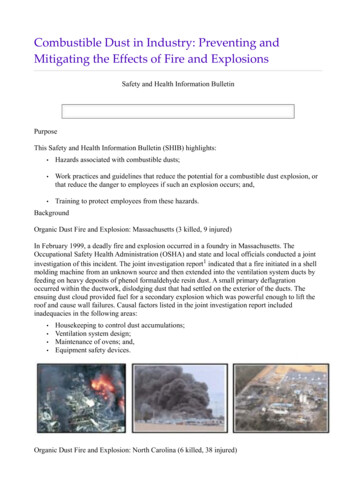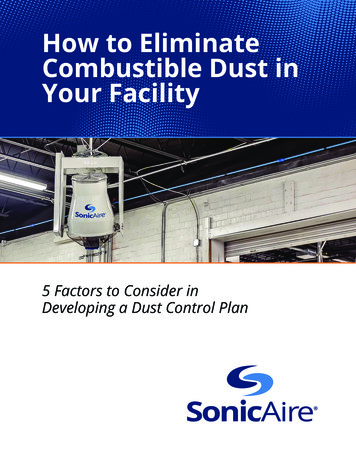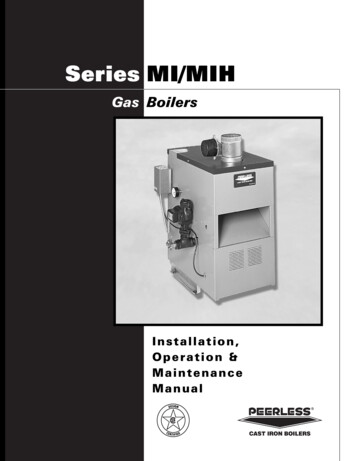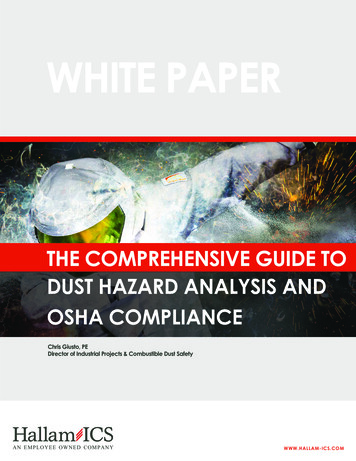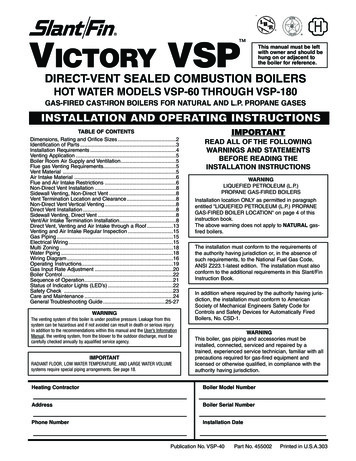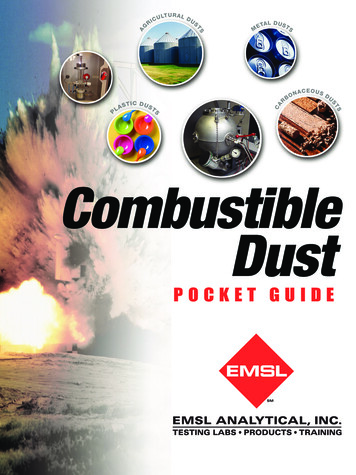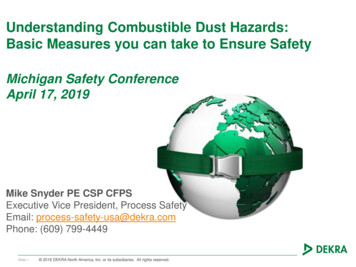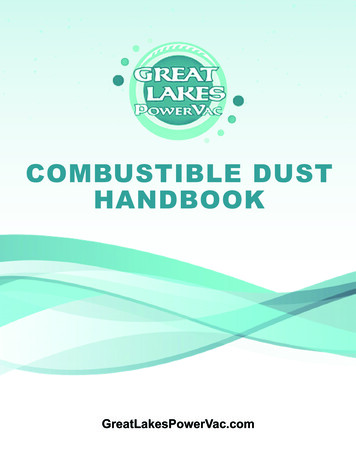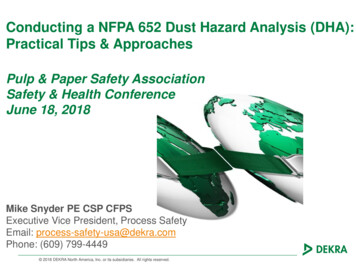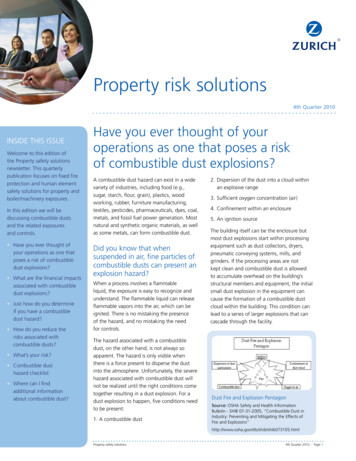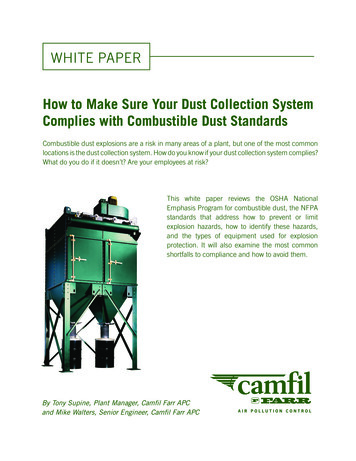
Transcription
WHITE PAPERHow to Make Sure Your Dust Collection SystemComplies with Combustible Dust StandardsCombustible dust explosions are a risk in many areas of a plant, but one of the most commonlocations is the dust collection system. How do you know if your dust collection system complies?What do you do if it doesn’t? Are your employees at risk?This white paper reviews the OSHA NationalEmphasis Program for combustible dust, the NFPAstandards that address how to prevent or limitexplosion hazards, how to identify these hazards,and the types of equipment used for explosionprotection. It will also examine the most commonshortfalls to compliance and how to avoid them. By Tony Supine, Plant Manager, Camfil Farr APCand Mike Walters, Senior Engineer, Camfil Farr APC
How to Make Sure Your Dust Collection System Complieswith Combustible Dust StandardsBy Tony Supine, Plant Manager, Camfil Farr APCand Mike Walters, Senior Engineer, Camfil Farr APCCombustible dust explosions are a risk in many areas of a plant, but one of the most common locations isthe dust collection system. How do you know if your dust collection system complies? What do you do ifit doesn’t? Are your employees at risk? What are the hazards and how do you identify them?The National Fire Protection Association (NFPA) sets standards and codes to protect buildings againstfire and explosion risks, and the Occupational Safety & Health Administration (OSHA) is enforcing thesestandards with increasing vigilance. When it comes to combustible dust, several standards must beconsidered. This white paper reviews the current status of the OSHA National Emphasis Program forcombustible dust, the NFPA standards that address how to prevent or limit explosion hazards, how toidentify these hazards, and the types of equipment used to eliminate or control explosion hazards. Wewill also examine the most common shortfalls to compliance and how to avoid them.The last decade: a look backIn January 2003, an explosion at theWest Pharmaceutical facility in Kingston, North Carolina killed six workersand injured 38 others, including twofirefighters. The culprit: inadequatecontrol of dust hazards at the plant.Only a month later, in February 2003,another explosion and fire damagedthe CTA Acoustics manufacturing plantin Corbin, Kentucky, fatally injuringseven workers. Investigators found thatresin dust, accumulated in a production area, was likely ignited by flamesfrom a malfunctioning oven, triggeringthe explosion.The most famous combustible dustexplosion in the past decade – and theone responsible for re-focusing thenational spotlight on this issue – wasthe February 2008 accident at theImperial Sugar Company’s Wentworth,These dust collectors are equipped with passive and active controls.Passive controls are an explosion vent and ducting that control thepressure and flame direction, and a rotary valve that contains the flame in thehopper. The active control is a chemical isolation system mounted on theinlet duct. Triggered by a pressure/flame detector, it will extinguish a flamefront passing through the inlet pipe before it goes back into the plant.White Paper: How to Make Sure Your Dust Collection System Complies with Combustible Dust Standards2
Georgia refinery. A dust cloud explosion triggered a fatal blast and fire that killed 13 workers and injured42 others, generating a storm of media attention and government scrutiny.These are by no means the only fatal explosions to occur in U.S. manufacturing plants, though they arethe three deadliest to be investigated. More recently, in December 2010, two brothers lost their lives in achemical explosion at the New Cumberland, West Virginia plant of AL Solutions. And during 2011, threedeadly fires and explosions occurred at a Hoeganaes Corp. plant in Gallatin, Tennessee. Investigatorsfound that accumulations of fine iron powder in the facility led to the explosions.In the U.S. alone in the 25 years between 1980 and 2005, the Chemical Safety Board reported 281explosions caused by ignited combustible dust. These explosions resulted in 199 fatalities and 718injuries. Combustible dust explosions over the past decade in U.S. plants are blamed for well over 100fatalities and hundreds more injuries. Sadly, experts believe these accidents could have been prevented if the companies involved had followed best practices for fire and explosion protection such as themethodologies described in this white paper.Agencies involvedThere are three key entities involved in combustible dust issues, each with its own particular area ofresponsibility:NFPA: The NFPA sets safety standards, amending and updating them on a regular basis. As noted, whenit comes to combustible dust, thereare several different documents thatcome into play, as summarized inthe section directly below. Together these standards add up to totalprotection to prevent an explosion,vent it safely, and/or ensure that itwill not travel back inside a building.Most insurance agencies and localfire codes state that NFPA standardsshall be followed as code. Exceptionswould be where the authority having jurisdiction (AHJ), such as FactoryMutual, specifies an alternative safety approach which might be evenmore stringent.This dust collector is equipped with an explosion vent with vertical upblastdeflector plate. Other safety features include a sprinkler system and filters withspecial carbon-impregnated media for static dissipation.OSHA: It is OSHA’s role, togetherwith local authorities, to enforcethe standards published by NFPA. InWhite Paper: How to Make Sure Your Dust Collection System Complies with Combustible Dust Standards3
the aftermath of the Imperial Sugar Companyexplosion in 2008, OSHA re-issued its 2007Combustible Dust National Emphasis Program(NEP) outlining policies and procedures forinspecting workplaces that create or handlecombustible dusts. As defined by OSHA, “Thesedusts include, but are not limited to: metal dustsuch as aluminum and magnesium; wood dust;coal and other carbon dusts; plastic dust andadditives; bio-solids; other organic dust suchas sugar, flour, paper, soap, and dried blood;and certain textile materials.” The revised NEP,which OSHA reissued on March 11, 2008, wasdesigned to ramp up inspections, focusing inparticular on 64 industries with more frequentand serious dust incidents.Figure 1: Penalty graph shows fines imposed from commencement of the OSHA Combustible Dust NationalEmphasis Program (NEP) in 2008 until October 2011.(Image courtesy of www.oshalawupdate.com)According to an October 2011 OSHA updateon its Combustible Dust NEP, since the commencement of inspections under the 2008 program, morethan 2,600 inspections have occurred. More than 12,000 violations were found during this timeframe,including more than 8,500 which are classified as serious. Federal penalties and fines for these violationshave totaled 22,738,909, with nearly another 1,600,000 in state fines. OSHA uncovered a variety ofdust collection violations in these inspections, including dust collectors that were not equipped withproper explosion protection devices and systems that were not vented to safe locations. (Figure 1)U.S. Chemical Safety Board (CSB): The CSB is an independent federal agency responsible for investigatingindustrial chemical accidents. Staff members include chemical and mechanical engineers, safety experts,and other specialists with chemical industry and/or investigative experience. The CSB conducts thoroughinvestigations of explosions like the ones mentioned above – sifting through evidence to determine rootcauses and then publishing findings and recommendations. The CSB has a wealth of information on theirweb site (www.csb.gov), including educational videos depicting how combustible dust explosions occur.The CSB has become an outspoken advocate of the need for more stringent combustible dustregulations and enforcement. On February 7, 2012, the fourth anniversary of the Imperial Sugarexplosion, the chairman of the CSB issued a statement in which he applauded the progress made to datein dealing with combustible dust issues. He noted, however: “Completing a comprehensive OSHA duststandard is the major piece of unfinished business from the Imperial Sugar tragedy . We believe sucha standard is necessary to reduce or eliminate hazards from fires and explosions from a wide variety ofcombustible powders and dust.” The CSB has also recommended that the International Code Council,which sets safety standards that are often adopted by state and local government, revise its standards torequire mandatory compliance with the detailed requirements of the various NFPA standards relating tocombustible dust.White Paper: How to Make Sure Your Dust Collection System Complies with Combustible Dust Standards4
The role of Congress: Some members of Congress are also advocating faster action by OSHA to implement a combustible dust standard. In February 2011, Representative George Miller of California,together with co-sponsors John Barrow of Georgia and Lynn Woolsey of California, re-introduced a bill titled The Worker Protectionagainst Combustible Dust Explosions and Fires Act (H.R. 522). If enacted, it would require OSHA to issue an interim standard within oneyear of passage and the Secretary of Labor to issue a proposed rule18 months later, with a final rule due within another three years. Atthe time of this writing, there has been no vote on H.R. 522. A similarbill passed the House in April 2008 but never went to the Senate.At the startup of a staged explosion,explosive dust is injected into the dustcollector to create a flammable cloud.Relevant NFPA StandardsIn trying to sort through the list of combustible dust standards, agood starting point for every plant engineer or manager is NFPA 654,the Standard for the Prevention of Fire and Dust Explosions from theManufacturing, Processing and Handling of Combustible ParticulateSolids. Simply stated, NFPA 654 is an all-encompassing standard onhow to design a safe dust collection system. It is regarded as theguiding dust document and the most general on the topic, and it willlead you to other relevant documents.About 5 milliseconds later, the dust ignites and the vent opens.Depending on the nature and severity of the hazard, NFPA 654 willguide you to the appropriate standard(s) for explosion venting and/or explosion prevention, as follows:NFPA 68 – Standard on Explosion Protection by Deflagration Venting:This document focuses on explosion venting – i.e., on devices andsystems that vent combustion gases and pressures resulting froma deflagration within an enclosure, for the purpose of minimizingstructural and mechanical damage. The current edition, publishedin 2007, contains much more stringent requirements than pasteditions, essentially elevating it from a guideline to a standard.The flame is almost immediately diverted away from the dust collector toa safe area.NFPA 69 – Standard on Explosion Prevention Systems: This standard covers explosion protection of dust collectors when ventingis not possible. It covers the following methods for prevention ofdeflagration explosions: control of oxidant concentration, controlof combustible concentration, explosion suppression, deflagrationpressure containment, and spark extinguishing systems.The smoke quickly clears. The wholeevent took about 150 milliseconds.White Paper: How to Make Sure Your Dust Collection System Complies with Combustible Dust Standards5
The general document (NFPA 654) also directs the reader to appropriate standards for specific manufacturing industries. The NFPA recognizes that different industries and processes have varying requirements,and it relaxes or tightens some aspects of its dust standards accordingly. Wood dusts, for example, tendto contain high moisture content that make for a potentially less explosive environment, resulting in aless stringent overall dust standard for that industry. Conversely, metal dusts can be highly explosive andsubject to more vigilant regulation.The industry-specific standards most commonly employed are:NFPA 61 – Standard for the Prevention of Fires and Dust Explosions in Agricultural and Food Processing Facilities. This standard covers facilities engaged in dry agricultural bulk materials including grains,oilseeds, agricultural seeds, legumes, sugar, flour, spices, feeds, and other related materials; facilitiesthat manufacture and handle starch; seed preparation and meal-handling systems of oilseed processingplants not covered by NFPA 36, Standard for Solvent Extraction Plants. Examples of facilities covered byNFPA 61 include but are not limited to bakeries, grain elevators, feed mills, flour mills, corn and rice milling, dry milk products, mix plants, soybean and other oilseed preparation operations, cereal processing,snack food processing, tortilla plants, chocolate processing, pet food processing, cake mix processing,sugar refining and processing, and seed plants.NFPA 484 – Standard for Combustible Metals. This standard covers all metals and alloys in a form thatis capable of combustion or explosion, and it outlines procedures that shall be used to determinewhether a metal is combustible or noncombustible form. It also applies to processing or finishing operations that produce combustible metal powder or dust such as machining, sawing, grinding, buffing andpolishing. Parts that contain multiple metals or alloys are subject to the requirements of the metal whosecombustion characteristics they most closely match. The standard also defines exclusions such as thetransportation of metals or the primary production of aluminum, magnesium, and lithium.NFPA 664 – Standard for the Prevention of Fire and Explosions in Wood Processing and WoodworkingFacilities. This standard establishes the minimum fire and explosion prevention requirements for facilitiesthat process wood or manufacture wood products using wood or cellulosic fibers, creating wood chips,particles, or dust. Examples include wood flour plants, industrial woodworking plants, furniture plants,plywood plants, composite board plants, lumber mills, and production-type woodworking shops andcarpentry shops that meet minimum requirements for plant size or dust collection flow rates.Using Performance-Based Codes: In 1995, the NFPA created a Performance-Based (PB) Support Team toassist NFPA Technical Committees with the transition to performance-based documents. Since that time,the NFPA has been incorporating performance-based options into its updated standards: The NFPA 654general dust document first adopted this concept in 2006, with the other more specific combustible duststandards following suit since that time. Using the newer performance-based codes, solutions no longerhave to follow NFPA standards to the letter if the variance is backed by full-scale, real-world destructivetest data.White Paper: How to Make Sure Your Dust Collection System Complies with Combustible Dust Standards6
Performance-based provisions state specific life safety objectives and define approved methods todemonstrate that your design meets these objectives. They give equipment manufacturers and plantengineers greater flexibility by allowing methods to quantify equivalencies to existing prescriptive-basedcodes or standards, as long as the proposed solution demonstrates compliance.A performance-based design procedure includes the following steps: (1) establish safety goals; (2) evaluate all aspects of the facility with regard to safety; (3) identify potential hazards; (4) define appropriatehazard scenarios; (5) establish performance objectives and criteria; (6) select calculation methods (e.g.computer models); (7) develop a proposed solution; (8) assess the solution; and (9) obtain approval.Technologies for explosion protectionThere are many types of devices and systems used to comply with NFPA standards for the explosionprotection of dust collection systems, but they fall into two general categories: passive and active.Passive systems react to the event, while active systems detect and react prior to or during the event.The goal of a passive system is to control an explosion so as to keep employees safe and minimize equipment damage in the plant. An active system, by contrast, canprevent an explosion from occurring. An active system involvesmuch more costly technology and typically requires re-certification every three months.Passive devices include: Explosion venting: Designed to be the “weak” link ofthe dust collector vessel, an explosion vent opens whenpredetermined pressures are reached inside the collector, allowing the excess pressure and flame front to exitto a safe area. It is designed to minimize damage to thecollector and prevent it from blowing up in the event of adeflagration, thereby reducing the safety hazard. (Figure 2) Flameless venting: Designed to install over a standardexplosion vent, a flameless vent extinguishes the flamefront exiting the vented area, not allowing it to exit thedevice. This allows conventional venting to be accomplishedindoors where it could otherwise endanger personnel and/or ignite secondary explosions. (Figure 3) Passive float valve: Designed to be installed in theoutlet ducting of a dust collection system, this valve utilizes amechanical barrier to isolate pressure and flame frontscaused by the explosion from propagating further throughFigure 2: A dust collector explosion ventdesigned in accordance with NFPA standards.Figure 3: Flameless venting deviceWhite Paper: How to Make Sure Your Dust Collection System Complies with Combustible Dust Standards7
the ducting. The mechanical barrier reacts within milliseconds and is closed by the pressure of theexplosion. Back draft damper: A mechanical back draft damper is positioned in the inlet ducting. It utilizes amechanical barrier that is held open by the process air and is slammed shut by the pressure forcesof the explosion. When closed, this barrier isolates pressure and flame fronts from being able topropagate further up the process stream. Flame front diverters: These devices divert the flame front to atmosphere and away from thedownstream piping. Typically, these devices are used between two different vessels equipped withtheir own explosion protection systems. The flame front diverter is used to eliminate “flame jetignition” between the two vessels that could overpower the protection systems installed.Active devices include: Chemical isolation: Designed to react within milliseconds of detecting an explosion, a chemicalsuppression system can be installed in either inlet and/or outlet ducting. Typical components includeexplosion pressure detector(s), flame detector, and a control panel. This system creates a chemical barrier that suppresses the explosion within the ducting and reduces the propagation of flamethrough the ducting and minimizes pressure increase within connected process equipment. Chemical suppression: Whereas chemical isolation is used to detect and suppress explosions withinthe ducting, chemical suppression protects the dust collector itself. It is often used, together withisolation, when it is not possible to safely vent an explosion or where the dust is harmful or toxic. Thesystem detects an explosion hazard within milliseconds and releases a chemical agent to extinguishthe flame before an explosion can occur. Fast acting valve: Designed to close within milliseconds of detecting an explosion, the valve installs ineither inlet and/or outlet ducting. It creates a mechanical barrier within the ducting that effectivelyisolates pressure and flame fronts from either direction, preventing them from propagating furtherthrough the process. High-speed abort gate: The gate is installed in the inlet and /or outlet ducting of a dust collectionsystem and is used to divert possible ignition hazards from entering the collector, preventing apossible explosion from occurring and preventing flame and burning debris from entering the facilitythrough the return air system. A mechanical barrier diverts process air to a safe location. Abort gatesare activated by a spark detection system located far enough upstream to allow time for the gate toactivate.When planning explosion protection, don’t overlook additional devices and materials that can helpreduce fire risk within the dust collection system. For spark-generating applications, a range of featuresand technologies are available, from flame-retardant and carbon anti-conductive filter media to sparkWhite Paper: How to Make Sure Your Dust Collection System Complies with Combustible Dust Standards8
arrestors in the form of drop-out boxes, perforated screens or cyclone device installed at thecollector inlet. Fire sprinkler systems may alsobe required with some installations.A dust collector that uses vertically-mounted filter cartridges can also reduce fire andexplosion risks. With horizontally-mountedcartridges, dust becomes trapped in the pleatsin the upper third of the filters (Figure 4). Thistrapped dust can burn even if the filter mediais fire retardant. Horizontal cartridges are alsoexposed to all of the dust entering the collector, coarse and fine. This leads to prematureFigure 4: Example of horizontally-mounted dust collector filtersfailure from abrasion and leaks. These leakscan go unnoticed for quite some time while fine combustible dust is blown into your facility. Verticallymounted filters use baffle systems to segregate much of the dust into the hopper, which reduces the loadon the filters and helps eliminate these problems.Mistakes, misconceptions and pitfallsA wide range of problems can contribute to explosion risk in a facility, but some common denominatorsexist. Based on years of field experience, the ones we have most commonly encountered are:Insistence on maintaining the status quo: “I’ve worked here for 30 years and we’ve never had aproblem” is a frequently heard response. This mindset stems in part from a common misconception thatthe dust is not explosive because the facility has not had an event– when in fact, the opposite may betrue. In some cases, it may take many years for dust to accumulate to explosive levels as seen in the CTAAcoustics event.To understand the risks, it is necessary to review thefive elements comprising what is known as the “dustexplosion pentagon” (Figure 5). They are (1) combustible dust; (2) an ignition source; (3) oxygen inthe air; (4) dispersion of the dust in sufficient concentration to be explosive; and (5) containment ofthe dust cloud within a confined or semi-confinedvessel or area. All five of these elements may exist in an industrial facility, but all must be present atthe same time for an explosion to occur. If there isno containment, it is still possible for a flash fire toerupt if elements #1-4 are present simultaneously.Figure 5: Dust explosion pentagon shows the elements thatmust be present for a combustible dust explosion to occur.White Paper: How to Make Sure Your Dust Collection System Complies with Combustible Dust Standards9
In a closed vessel such as a cartridge dust collection system, an explosion typically begins when anignition source enters the dust collector. This ignition source can come from many things and in mostcases is never identified. When a pulse cleaning event occurs, a suspended cloud of combustible dust ispresent in high concentration within the collector. This completes the five elements of a dust explosionand initiates the explosion.Though some incidents involve a single explosion, it is more common for a series of deflagrations tooccur. The initial explosion can dislodge ignitable dust hidden on overhead surfaces or other areas overa large area and trigger secondary explosions that can be ignited from the initial explosion or from otherignition sources. It is these secondary explosions that have historically caused the majority of injuries anddamage to property.How do you know if your facility is at risk? Even if there has never been a problem before, this is noguarantee of future safety. The level of hazard can change from day to day and even from moment tomoment – whether due to the introduction of a new process, a temporary lapse in housekeeping, or astatic electricity discharge caused by improper grounding. It takes ongoing vigilance and management ofchange to identify conditions in your plant thatmight cause a potential safety problem.Kst Values of Common DustsLack of a risk evaluation or hazard analysis:Failure to conduct a hazard analysis is an alltoo common oversight. The NFPA states thata hazard analysis is needed to assess risk anddetermine the required level of fire and explosion protection. The analysis can be conductedinternally or by an independent consultant, buteither way the authority having jurisdiction willultimately review and approve the findings.Regarding explosion protection, the first stepin a hazard analysis is determining whetheryour dust is explosive. Many commercial testlaboratories offer a low-cost test to establishwhether a dust sample is combustible. If thetest is positive, then the explosive index (Kst)and the maximum pressure rise (Pmax) of thedust should be determined by ASTM E 1226-10,Standard Test Method for Explosibility of DustClouds.Common DustsMicronActivated CarbonAluminum GritAluminum PowderAsphaltBarley Grain DustBrown CoalCharcoalCottonMagnesiumMethyl CelluloseMilk PowderPaper Tissue DustPectinPolyurethaneRice StarchSiliconSoapSoy Bean FlourSulphurTobaccoTonerWood t 1111015112145102Figure 6: Kst values of common dustsWhite Paper: How to Make Sure Your Dust Collection System Complies with Combustible Dust Standards10
Your dust collection equipment supplier will need the Kst and Pmax values in order to correctly sizeexplosion venting or suppression systems. Failure to provide this information will increase your costs,since the supplier will have to use worst-case estimates of the Kst and Pmax values or may even refuse toprovide the equipment. The liability to the manufacturer and to the equipment purchaser is too high toignore the life safety objectives.The fact is, any dust above 0 Kst is now considered to be explosive, and the majority of dusts fall intothis category. If OSHA determines that even a very low Kst dust is present in a facility with no explosionprotection in place, a citation will result. This is one of the biggest changes to occur with the re-introduction of the OSHA NEP in 2008. Figure 6 shows the Kst values of a number of common dusts.Bargain-hunting: Every plant engineer and manager is acquainted with the benefits of basingpurchasing decisions on life-cycle cost – sometimes called “total cost of ownership” – over choosingequipment with the lowest price tag. A dust collector is no exception. A well-designed dust collectionsystem can pay for itself rapidly in energy and maintenance savings, costing far less to operate than a unitwith a low initial price.A high-quality, heavy duty collector can alsooffer a less obvious advantage in the event ofa combustible dust problem. As documentedboth in full-scale testing and field experience,in the event that a dust explosion occurs in thecollector, a “bargain” model will more thanlikely require total replacement. A collectormade of thicker-gauge metal with higher vessel strength, however, will survive an explosionand can often continue in service with only theexplosion vent and filter cartridges needing tobe replaced.Using non-compliant devices: A close cousinto the bargain-hunting issue involves the useof non-compliant or uncertified explosionprotection devices. As an example, sometimesproducts such as back flap dampers may bereverse-engineered by suppliers that do nothave any expertise in explosion protectionor have chosen not to perform the requiredtesting to satisfy the standards and/or theperformance-based provisions. No testingexists to prove that the device will comply withcurrent standards.Photos of a factory taken before and after installation of a dustcollection system show how effectively the collector cleans uphazardous dust and fumes.White Paper: How to Make Sure Your Dust Collection System Complies with Combustible Dust Standards11
If an OSHA inspector finds this situation in the field, the plant will have to replace the device and may besubject to a fine. Worse yet, if a combustible dust problem should occur, there is no guarantee that thedevice will perform as expected.It is also worth noting, there is no such thing as an “NFPA-approved” device. A supplier may correctly statethat a device “carries CE and ATEX certifications” and/or is “manufactured in accordance with NFPA standards” – but test data must be available to support these claims. Such a device might cost more than itsnon-compliant counterpart, but in the long run it can save money, headaches, and even lives.Housekeeping problems: In an October 2011 update on the Combustible Dust NEP, OSHA reported thatone common violation encountered during inspections involved “hazardous levels of dust accumulationin the workplaces due to poor housekeeping practices”. In the authors’ experience, as a rule of thumb, ifan OSHA inspector can run his finger across a dusty surface or see a footprint, that is considered a citablecondition.Diligent cleanup of floors and work surfaces is still not enough if more elevated areas are neglected: Dustthat accumulates on rafters and other horizontal overhead surfaces, or on top of machinery, is a frequentculprit. Also, the NFPA recently tightened its definition of hazardous surface dust (in NFPA 654), definingit as any dust layer of 1/64 inch (0.4 mm) or greater, compared to a previous limit of 1/32 inch (0.8 mm)of dust.When it comes to the dust collector, a simple but important housekeeping requirement is to changefilters when airflow through the system reaches a differential pressure limit as pr
ing faster action by OSHA to implement a combustible dust stan-dard. In February 2011, Representative George Miller of California, together with co-sponsors John Barrow of Georgia and Lynn Wool-sey of California, re-introduced a bill titled The Worker Protection against Combustible Dust Explosions and Fires Act (H.R. 522). If en-

